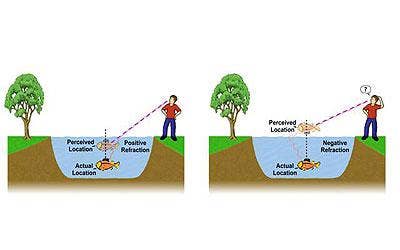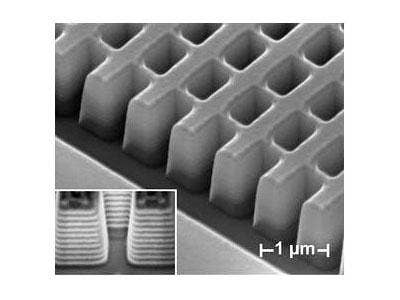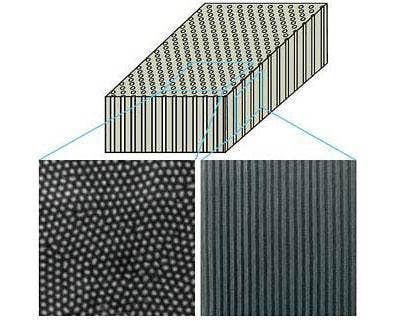Can You See Me Now? Scientists Further Invisibility Shield Research

Scientists at the University of California, Berkeley have engineered 3-D materials that can reverse the natural direction of visible and near-infrared light. As a result, the research raises the possibility that someday people can use the material in cloaking devices that render objects invisible to the human eye. That type of tactical technology goes well beyond the realm of H.G. Wells and Harry Potter, especially considering that some of the project's funding came from the U.S. Army Research Office and the U.S. Air Force Office of Scientific Research.
However, the researchers cautioned that they are still far off from invisibility cloaks and other applications. Developing a way to manufacture these materials on a large scale will be a challenge, they said.
"Unlike the cloak made famous in the Harry Potter novels, the metamaterials described here are made of metal and are fragile," said the scientists in a statement.
To create invisibility cloaks or shields, material would need to curve light waves completely around an object like a river flowing around a rock, the scientists said. For optical microscopes to discern individual, living viruses or DNA molecules, the resolution of the microscope must be smaller than the wavelength of light.
Two breakthroughs in the development of metamaterials -- composite materials with extraordinary capabilities to bend electromagnetic waves -- are reported separately this week in the Aug. 13 advanced online issue of Nature and in the Aug. 15 issue of Science.
Here is an illustration of how a fish in water is seen by an observer through positive refraction (left), and negative refraction (right), with the squiggly red lines marking the refraction of light and the purple lines representing the path towards the perceived location of the fish, which appears above its actual location.

The scientific breakthroughs came in the development of metamaterials -- composite materials with extraordinary capabilities to bend electromagnetic waves -- that can achieve a negative index of refraction at optical frequencies.
In one project, researchers stacked together alternating layers of silver and non-conducting magnesium fluoride and cut nanoscale-sized fishnet patterns into the layers to create a bulk optical metamaterial. At wavelengths as short as 1500 nanometers, the near-infrared light range, researchers measured a negative index of refraction. For a metamaterial to achieve negative refraction, its structural array must be smaller than the electromagnetic wavelength being used.
The fishnet material is strongly interacting nanocircuits that allow light to pass through the material and expend less energy moving through the metal layers, the scientists reported.
This is a schematic of the first 3-D "fishnet" metamaterials.

The common thread in metamaterials is negative refraction, the researchers noted, but in contrast, all materials found in nature have a positive refractive index, a measure of how much electromagnetic waves are bent when moving from one medium to another. "Natural materials do not respond to the magnetic field of light, but the metamaterial we created here does," said Jason Valentine, A U.C. Berkeley graduate student and co-lead author of the Nature paper. "It is the first bulk material that can be described as having optical magnetism, so both the electrical and magnetic fields in a light wave move backward in the material."
To better explain how refraction works, researchers gave the example of looking at the submerged part of a pole inserted into water, which will appear as if it is bent up towards the water's surface. If water exhibited negative refraction, the submerged portion of the pole would instead appear to jut out from the water's surface. Or, to give another example, a fish swimming underwater would instead appear to be moving in the air above the water's surface, they said.
This is a scanning electron microscope image of the fabricated structure, developed by U.C. Berkeley researchers. The alternating layers form small circuits that can bend light backwards.

In the Science paper, the metamaterial takes another approach to bending light backwards. It is composed of silver nanowires grown inside porous aluminum oxide, the scientists said. They acknowledged that the structure is about 10 times thinner than a piece of paper, but it is still considered a bulk metamaterial because it is more than 10 times the size of a wavelength of light.
The authors of the paper said that they observed negative refraction from red light wavelengths as short as 660 nanometers, marking the first demonstration of bulk media bending visible light backwards. The innovation of this nanowire material, researchers said, is that it finds a new way to bend light backwards without technically achieving a negative index of refraction.
Both the nanowire and fishnet metamaterials can potentially play a key role, the researchers said, for most of the applications touted for metamaterials, such as nanoscale optical imaging or cloaking devices, said the researchers.
Here is a schematic and two scanning electron microscope images with top and side views of a metamaterial developed by UC Berkeley researchers. The material is composed of parallel nanowires embedded inside porous aluminum oxide. As visible light passes through the material, it is bent backwards in a phenomenon known as negative refraction.